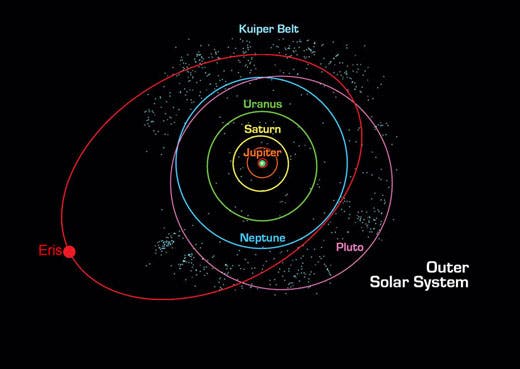Nibiru followers might have cause to rejoice, as Spanish astronomers report a novel hypothesis that suggests two Earth-sized planets might be hiding out in the outskirts of our solar system. Thousands of years after the first planets besides our own were discovered by ancient Babylonian astronomers, it seems like determining the number of planets in our solar is far from being settled, despite Pluto’s unfortunate destitution.
Nine, eight… ten planet?

Evidence of the two planets came after scientists observed unusual effects in the so-called “extreme trans-Neptunion objects”, a belt of space rocks that lie well beyond Neptune’s orbit. You might be surprised to find Neptune was for some time the farthest planet in the solar system. Because Pluto has an orbit around the Sun which is very elliptical, there are times when it crosses Neptune’s orbit and becomes closer to the Sun than Neptune. For 20 years, from 1979 to 1999, Neptune was actually farther from the sun than Pluto. For now, Pluto is back to being farther from the sun. It will be more than 230 years before Neptune and Pluto trade places again. Generally, because Pluto’s orbit takes it both within and without Neptune’s orbit, Pluto is considered a trans-Neptunion object. Like Pluto, there are another 1,500 such objects or minor planets.
Scientists would normally expect these objects to be randomly distributed. In reality, it seems they’re moving in completely unexpected ways, which seem to indicate that they’re being pulled by something that can’t be seen. This effects bears the name “Kozai mechanism”, by which a large body disturbs the orbit of a smaller and more distant object. “In this scenario, a population of stable asteroids may be shepherded by a distant, undiscovered planet larger than the Earth … ” the researchers write in a paper in the journal Monthly Notices of the Royal Astronomical Society Letters. The team is made of researchers at the Complutense University of Madrid and the University of Cambridge.
Professor Carlos de la Fuente Marcos, from the Complutense University of Madrid (UCM), quoted by the Spanish scientific news service (Sinc), said: “This excess of objects with unexpected orbital parameters makes us believe that some invisible forces are altering the distribution of the orbital elements of the Etno, and we consider that the most probable explanation is that other unknown planets exist beyond Neptune and Pluto.
The unexplored solar system

You’d think that in the 21st century, when astronomers study planets outside our system and have discovered more than 1,000 such exoplanets, that imaging any such objects within our own solar system is a trivial matter. Our solar system is a much vaster place than most people think though. Beyond Neptune, the last confirmed planet, the solar system continues with the Kuiper belt and the Oort cloud. The Kuiper belt is a doughnut shaped region of space beyond Neptune that contains many small icy worlds. The Oort cloud is a spherical shell farther out still that contains small chunks of dirty ice and is likely the source of many long period comets that sometimes fall into the inner solar system. Short period comets likely come from the Kuiper belt.
These two ares are still very jagged and we know very little about what lies within it or even farther beyond. Missions like the New Horizon probe, which is just reaching Pluto, will help scientists answer part of the riddles that bother them. But is there a chance that a planet, by its definition today, might linger in our solar system hidden away from any previous observations? If we’re to judge planetary formation models, this would be unlikely. Computer simulations of the formation of the Solar System state there are no other planets moving in circular orbits beyond Neptune. But this hypothesis is not necessarily correct, as a recent discovery of a planet-forming disk of dust and gas more than 100 astronomical units (AU) from the star HL Tauri points out. An astronomical unit is the average distance between the Earth and the Sun. Pluto’s average distance from the sun is 39.5 AU, the Kuiper belt ranges from 30 AU (the average distance of Neptune) to 55 AU, while the Oort cloud ranges from 5 thousand to 100 thousand AU. Yes, the solar system is an extremely big place. Just consider the Voyager probe has traveled more than 20 billion kilometers and it still hasn’t left our solar system, though some say it has.
This latest findings suggest that planetary formation beyond Neptune is indeed possible. Not only this; as many as two planets could lie in the outer solar system.
“The exact number is uncertain, given that the data that we have is limited, but our calculations suggest that there are at least two planets, and probably more, within the confines of our Solar System,” the researchers write.
On the other hand, the team recognises that the analysis is based on a sample with few objects (specifically 13), but they point out that in the coming months more results are going to be published, making the sample larger.
“If it is confirmed, our results may be truly revolutionary for astronomy,” says de la Fuente Marcos.






